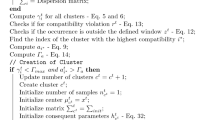Abstract
A strategy for improving speed of the previously proposed evolving neuro-fuzzy model (ENFM) is presented in this paper to make it more appropriate for online applications. By considering a recursive extension of Gath–Geva clustering, the ENFM takes advantage of elliptical clusters for defining validity region of its neurons which leads to better modeling with less number of neurons. But this necessitates the computing of reverse and determinant of the covariance matrices which are time consuming in online applications with large number of input variables. In this paper a strategy for recursive estimation of singular value decomposition components of covariance matrices is proposed which converts the burdensome computations to calculating reverse and determinant of a diagonal matrix while keeping the advantages of elliptical clusters. The proposed method is applied to online detection of epileptic seizures in addition to prediction of Mackey–Glass time series and modeling a time varying heat exchanger. Simulation results show that required time for training and test of fast ENFM is far less than its basic model. Moreover its modeling ability is similar to the ENFM which is superior to other online modeling approaches.






Similar content being viewed by others
References
Takagi T, Sugeno M (1985) Fuzzy identification of systems and its application to modeling and control. IEEE Trans Syst Man Cybern 15:116–132
Sugeno M, Kang GT (1988) Structure identification of fuzzy model. Fuzzy Sets Syst 28(1):15–33
Jang JS (1993) ANFIS: adaptive-network-based fuzzy inference system. IEEE Trans Syst Man Cybern 23(3):665–685
Nelles O (1996) Local linear model tree for on-line identification of time invariant nonlinear dynamic systems. In: Proceedings of international conference on artificial neural networks (ICANN), Bochum, Germany, pp 115–120
Mamdani EH, Assilian S (1975) An experiment in linguistic synthesis with a fuzzy logic controller. Int J Man Mach Stud 7:1–13
Jang J-SR, Sun CT, Mizutani E (1997) Neuro-fuzzy and soft computing: a computational approach to learning and machine intelligence. Prentice-Hall, Upper Saddle River
Nelles O (2001) Nonlinear system identification. Springer, Berlin
Platt J (1991) A resource allocation network for function interpolation. Neural Computation 3:13–225
Fritzke B (1995) A growing neural gas network learns topologies. Adv Neural Inf Process Syst 7:625–632
Kasabov N (1998) Evolving fuzzy neural networks-algorithms, applications and biological motivation. In: Methodologies for the conception, design and applications of soft computing. World Scientic, Singapore, pp 271–274
Deng D, Kasabov N (2000) Evolving self-organizing maps for online learning, data analysis and modeling. In: Proceedings of IJCNN 2000 neural networks, neural computation: new challenges perspectives new millennium, Como, Italy, pp 3–8
Kasabov N, Song Q (2002) DENFIS: dynamic evolving neural-fuzzy inference system and its application for time-series prediction. IEEE Trans Fuzzy Syst 10(2):144–154
Angelov PP, Xydeas C, Filev D (2004) An approach to online identification of takagi-sugeno fuzzy models. IEEE Trans Syst Man Cybern B 34(1):484–498
Lughofer ED (2008) FLEXFIS: A Robust Incremental Learning Approach for Evolving Takagi–Sugeno fuzzy models. IEEE Trans Fuzzy Syst 16(6):1393–1410
Hametner C, Jakubek S (2006) New concepts for the identification of dynamic Takagi–Sugeno fuzzy models. In: IEEE computer intelligent society, 2006, pp 761–766
Angelov PP, Zhou X (2006) Evolving fuzzy systems from data streams in real-time. In: Proceedings of IEEE international symposium on evolving fuzzy systems, 2006, pp 29–35
Martinez B, Herrera F, Fernandez J, Marichal E (2008) An incremental clustering method and its application in online fuzzy modeling. Stud Fuzziness Soft Comput 224:163–178
Mirmomeni M, Lucas C, Araabi BN (2009) Introducing recursive learning algorithm for system identification of nonlinear time varying processes. In: Proceedings of 17th mediterranean conference on control and automation, Thessaloniki, Greece, pp 736–741
Soleimani-B. H, Lucas C, Araabi BN (2010) Recursive Gath-Geva clustering as a basis for evolving neuro-fuzzy model. Evol Syst 1(1):59–71
Chiu SL (1994) Fuzzy model identification based on cluster estimation. J Intell Fuzzy Syst 2:267–278
Champagne B (1994) Adaptive eigendecomposition of data covariance matrices based on first-order perturbations. IEEE Trans Signal Proc 42(10):2758–2770
Erdogmus D, Rao YN, Peddaneni H, Hegde A, Principe JC (2004) Recursive principal component analysis using eigenvector matrix perturbation. EURASIP J Appl Signal Process 13:2034–2041
Ocak H (2008) Optimal classification of epileptic seizures in EEG using wavelet analysis and genetic algorithm. Signal Proc 88:1858–1867
Firpi H, Goodman ED, Echauz J (2007) Epileptic seizure detection using genetically programmed artificial features. IEEE Trans Biomed Eng 54:212–224
Theodore W, Fisher R (2004) Brain stimulation of epilepsy. Lancet 3:111–118
Iasemidis L, Sackellares J, Zaveri H, Williams W (1990) Phase space topography and the lyapunov exponent of electrocorticograms in partial seizures. Brain Topogr 2:187–201
Third International Workshop of Seizure Prediction (2009) https://epilepsy.uni-freiburg.de/prediction-contest/data-download
Hyvarinen A, Oja E (2000) Independent component analysis: algorithms and applications. Neural Netw 12:411–430
Subasi A (2007) EEG signal classification using wavelet feature extraction and a mixture of expert model. Expert Syst Appl 32:1084–1093
Kandaswamy A, Kumar CS, Ramanathan RP, Jayaraman S, Malmurugan N (2004) Neural classification of lung sounds using wavelet coefficients. Comput Biol Med 34:523–537
Mackey M, Glass L (1977) Oscillation and chaos in psychological control systems. Science 197:281–287
Bittanti S, Piroddi L (1996) Nonlinear identification and control of a heat exchanger: a neural network approach. J Frankl Inst 334(1):135–153
DaISy (2009) A database for identification of systems. http://www.esat.kuleuven.be/sista/daisy
Author information
Authors and Affiliations
Corresponding author
Rights and permissions
About this article
Cite this article
Soleimani-B., H., Lucas, C. & Araabi, B.N. Fast evolving neuro-fuzzy model and its application in online classification and time series prediction. Pattern Anal Applic 15, 279–288 (2012). https://doi.org/10.1007/s10044-011-0203-4
Received:
Accepted:
Published:
Issue Date:
DOI: https://doi.org/10.1007/s10044-011-0203-4




